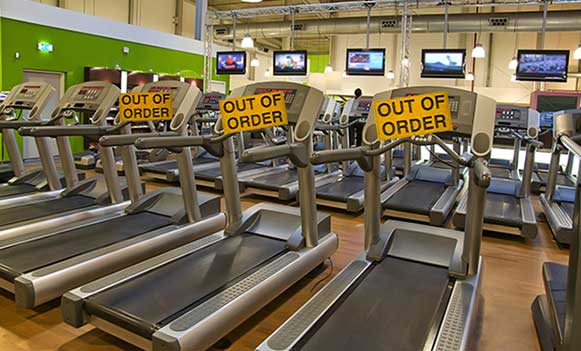
The first signs of terminal gym illness appeared after Labor Day. On a cool, late September morning, I climbed on one of the elliptical machines in the cardio area and from my slightly elevated perch found myself staring at an OUT OF ORDER sign placed on the handlebars of the stationary bike in front of me.
Looking around, I saw a similar sign on one...no, wait, two!...of the treadmills. And there was one on a nearby elliptical. And...are you kidding me?...yet another on the Stairmaster machines. Out of about 40 cardio machines, six were broken. I dismissed it as an odd run of mechanical bad luck.
This is a local gym, not known for its amenities. Yet, when I returned the following week and all six cardio machines were still broken, I began to wonder.
No frills is fine—but no fix?
The problem was evident in the weight room, too. When I sat down to do a set of leg extensions, I found the back of my knees resting on raw wood: The seat covering looked like it had been chewed through by a pack of hungry mice. A nearby leg press machine had apparently decided to join its cardio brethren in a work stoppage. It, too, declared itself OUT OF ORDER.
The machines weren’t the only things out of action. The long-time trainers who always brought in some morning energy and cheer into the gym along with their tall cups of coffee and cans of Red Bull, were nowhere to be seen. Neither were their clients.
Or, come to think of it, was anyone else.
I scoured the floor: eight people working out at 8 a.m. on a Monday. A number of familiar faces had vanished. Where? Why? What did they know that I didn’t?
The previous week, the friendly twentysomething who worked the front desk had just shrugged when I asked her about the broken machines. “I don’t know what’s going on,” she said apologetically.
Now she was among the missing, too. In her place, a grim-faced young guy who stared at his phone, his hoodie pulled up over his head, and refused to make eye contact. Clearly, I should talk to a manager. But....well, just who was that? The glass-enclosed office where the previous manager had sat was now vacant. While flyers posted on the bulletin board by the entrance promised various classes, the group fitness room was church quiet.
I couldn’t help but draw the conclusion:
This gym was dying.
HOW DO YOU KNOW?
“Bad signs?” said Leigh Anne Richards, manager and co-owner of MetroFitness, in Montgomery, Alabama, when I ticked off the litany of problems at my gym. “They’re horrible signs!”
Richards has managed Metro Fitness for 16 years and also teaches group exercise classes there. She sympathizes with any health and fitness professionals who find themselves working at a gym in trouble, because she’s been there. In 2012, Metro Fitness hit a rough patch: Membership dropped and there were concerns that the club couldn’t remain open.
While she and her business partner tried to come up with a solution, she took a few steps to alter the perception that the management of my gym overlooked. “I remember a recumbent bike sitting there for weeks with an out-of-order sign,” she says. “I finally said, ‘If we’re not going to get this fixed, take it off the floor.’”
Eventually, the bike was fixed—as was the club. Three years later, thanks in part to the addition of a new functional training area and upgrading some existing equipment, Metro Fitness is healthy.
As is the health-club industry in general, based on the proliferation of new facilities. According to the International Health, Racquet and Sportsclub Association’s annual tally, published in 2014, the number of gyms (including everything from full-service health clubs to boutique one-on-one studios) rose from 30,500 in 2012 to 32,150 in 2013: An increase of 1,650.
In such an environment, and an improving economy, one should be careful of making assumptions about a club’s future—even when the indicators, as at my gym, suggest that there is no future.
“They’re signs of change,” says Garrett Jones, manager of Eastern Athletic Clubs, a chain of five New York-area gyms. “Worst-case scenario is that they’re about to close the doors. Another scenario could be that another owner or franchise is about to take over. It could be a transition while they’re waiting for licensing. It could be that they’re reorganizing, or that they’re waiting for additional financing to come through. All of those are possible.”
WHAT SHOULD YOU DO?
Okay, so it’s often hard, from the trainer or instructor’s level, to know what ownership is doing. But the same problems you might notice in an ailing club will probably be noticed by the membership, too.
And who do you think they’re going to ask about it?
“It can put you in a difficult position,” says Larry Indiviglia, an ACE Certified Personal Trainer in San Diego, who found himself in exactly such a position in 2008. “We started noticing a downturn. Equipment was not repaired in a timely fashion. Things needed to be repaired and weren’t. The towel service was cancelled, and the cleanliness of the club began to suffer. Also, ownership wasn’t around that much. In retrospect, that was a key sign.”
Without an onsite manager, Indiviglia and other trainers and instructors had to field the questions and complaints. “I would get, ‘Hey, the treadmill is broken,’” he says. In situations like that, “You owe it to yourself to feed back any comments to ownership. Preferably in writing, so that they’re aware of what members are feeling at this point.”
Richards agrees. “I would go to management and say, ‘I am concerned and need to speak to you. This is what I’ve seen and these are the questions I’m getting from members.’”
After all, good managers listen to customers—and employees. “When you have lack of communication, that causes rumors and conjecture,” Indiviglia says.
And when the answer to your e-mails or calls is no response, then it’s time to start thinking not just about the club’s prospects—but your future, as well.
That doesn’t mean running over to the gym around the corner, begging for a job and trashing your current employer to the competition, no matter how frustrated you may feel. “Don’t go out of your way to bad mouth them,” says Indiviglia. “You don’t have to say, ‘The place is a dump.’ You can explain your concerns diplomatically. A perceptive owner will pick up on that.”
How long do you wait to begin looking elsewhere?
“I say, don’t wait,” says Indiviglia. “Be proactive, be reactive.”
Indiviglia took action: By the time his gym was sold again in 2010 (it subsequently went out of business), he had a new job at a different gym in San Diego—Todd Durkin’s Fitness Quest 10—which is where he works today.
During his 42 years in the business, Jones says he has hired many trainers and instructors from failing clubs. “The fact that you’re concerned about the health of the club you’re currently working at, is very reasonable,” he says. “It’s also an opportunity. From my point of view, we’re always looking for good people.”
WHAT DO YOU TELL YOUR CLIENTS?
“If management is up front with you it’s different,” says Bob Phillips, a long-time independent personal trainer in New York. “If they’re saying, ‘We’re restructuring’ or whatever....well, that’s fine. You can tell your clients, ‘Don’t worry, I think it will be okay.’”
However, if you’ve established—most likely through a deafening silence from management—that the troubling signs you and the membership have noticed seem to mean a gym about to go under, then what do you say?
In such cases, you have to ask yourself who you’re really serving. “As an independent trainer, I feel I’m working as much for my clients as I am for the club,” Phillips says. “I would say something like, ‘Okay, we can see the gym is in disrepair, and we don’t really know what’s going on. We’ve voiced our concerns and have heard nothing. So let me look around and check out a few places, just in case. That way, we’ll have a Plan B if the worst happens.’”
In these types of situations, good trainers and instructors will generally be rewarded—if not by management then by the loyalty of their clients or students. “If you are prepared, professional and personable with your clients,” Indiviglia says, “in most cases, they will follow you to your new place.” (Of course, whether they stay there depends on other factors beyond your control, such as the membership fees at the new gym and the amenities there.)
Phillips emphasizes that, in larger national chains, where trainers may be on staff and the organizational resources are greater, the dying-gym scenario is probably less likely to happen. But for independent trainers and those working in mom-and-pop gyms or mid-sized chains, it’s a reality of the business. “I have been in that situation,” says Phillips, who has been a personal trainer for more than 25 years. “Among trainers of a certain age, it would be rare to find ones who haven’t been.”
For these individuals, as for any health and fitness professional—whether full- or part-time—you have to protect yourself. “It’s a serious thing,” Phillips says. “You don’t have any union reps to file a grievance with, no board of appeals. In most cases, there’s no severance. You’re just out.”
So be prepared. As in any other profession, you need to keep your résumé updated. But remember also that trying to read the tea leaves on the future of a business is tricky.
Case in point: Arriving on a Monday in the second week of January, I found that the OUT OF ORDER signs were gone, and the machines were repaired.
Has my dying gym been resuscitated? We live in hope.





 by
by 


